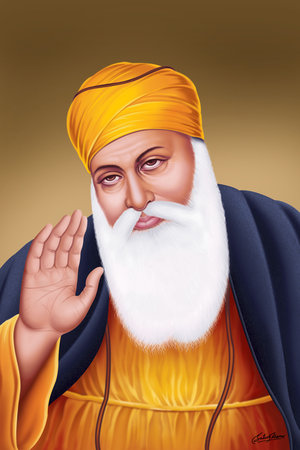I am so sorry I haven't been able to post in such a long time. There was a bit of an emergency I had to deal with so I've been preoccupied with that but I'm hoping to start posting more regularly again. This is a paper I wrote for a religion class -- I do not practice Sikhism myself, but it is a religion which intrigues me. Eventually this paper will turn into a for-against paper for a final project and will ultimately be ten pages or so, but this is part one. I hope you learn a little bit about Sikhism and if you already know about Sikhism, I'd love to talk to you!
As
the fifth most popular religion in the world, Sikhism serves the spiritual
needs of many individuals. Because the
followers of the tradition represent such a large population of the world, that
others have some understanding of this largely misunderstood religion is vital. Despite the many misapprehensions associated
with Sikhism, the Sikh tradition indoctrinates equality and tolerance in its
followers.
Of
approximately seven billion people populating the world, .36% practice
Sikhism. “There are 25 million Sikhs
around the world, Singh says, about 700,000 which live in the United
States. Most Sikhs are in India”
(Almasy). Of 25 million Sikhs, about half
must be women. Therefore there are 12.5
million practicing female Sikhs. Their
prevalence in the Sikh culture is the same in any other culture, yet unlike
other religions, theirs preaches for their equality.
From the beginning of the
tradition, Sikhism has striven to include women members in every way a Sikh man
may participate. Guru Nanak made it
clear that women would be allowed the same admission to
 |
| A Sikh woman |
In
partnerships, women continue to function as an equal. Like Guru Nanak, Guru Amar Das felt women
held the same value as men. Guru Amar
Das criticized an accepted marriage practice which involved wives throwing
themselves onto the funeral pyres of their dead husbands. His disapproval of monogamy further suggested
an equal give-and-take in marriage (Kaur).
The Sikh tradition has valued and continues to value Sikh women the same
as it values Sikh men. “From the
beginning, Sikh women were seen as partners as Sikh men. Married life, not celibacy, was seen as the
ideal” (Oxtoby and Segal 345). Though
this is not to suggest that women hold a higher place than religion in the
lives of men, it does suggest they and their relationships with men are
important to the religion. Women’s
importance in Sikhism is equal to that of men’s.
Women are not only equals as partners, but as
individuals as well. “[Guru Amar Das]
thought all women should be educated and have the same access to education as
men” (Kaur). Guru Amar Das believed in
women could and should also make their own choices regarding wardrobe, like any
man could. In addition to making
decisions for themselves, Sikh women are urged to protect the lives of
themselves and others. “Guru Gobind
Singh encouraged women to be warrior-like and to fight against those who
persecuted them because of their faith” (Kaur).
In a world where women are typically expected to leave fighting of any
kind to their male counterparts, Sikhism takes a stand. Sikhs believe in the ability of women to
fight for themselves and their religion without the help of a man, once again
emphasizing their equality with men.
In addition to their
advocacy for women, Sikhs believe in equality for all humans who inhabit the
earth, regardless of their religious affiliation. Unlike other religions, Sikhs do not attempt
to convert people who do not believe in Sikhism to Sikhism. “…the emphasis in Sikhism has been less on
converting others and more on allowing human beings freedom to find their own
destiny and salvation in their own way” (Singh). This suggests that Sikhs view all paths to
salvation valid and equal. The attitude
toward other
 |
| Guru Nanak |
Other religions may feel
differently, and there have been cases in which the followers of one religion
“punished” another for believing differently.
Despite this, Sikhs have never “desecrated a Hindu temple, the idols
therein, or any mosque” (Singh). The
acceptance of other religions does not mean a lack of belief in Sikhism. In fact, it may mean an increase in a Sikh’s
beliefs as one of the prayers which Sikhs read every day “ends with the plea
for betterment of all mankind, not that of Sikhs alone to the exclusion of
everyone else.” This includes agnostics
and atheists in addition to other religions (Singh). In accepting others and their religions,
Sikhs clearly express a tolerance and belief in the equality of citizens of the
world.
Sikhs not only practice equality
of all religions on a large scale, but in individual instances as well. There are various examples of this throughout
Sikh history. Guru Nanak accepted
followers of other religions to follow his teachings. One of his most devout followers began as a
man who worshiped the Hindu god Durga.
Soon after he converted to Sikhism and continued to shadow Guru Nanak
(“The First Master”). “[Guru Nanak]
travelled widely to both Hindu and Muslim places of pilgrimage and his two
constant companions throughout were Mardana, a Muslim, and Bola, a Hidu”
(Singh). While serving the injured warriors in battle, Bhai Kanhayya, a Sikh,
did not differentiate between enemies and allies when dispensing care
(Singh). Perhaps even more dramatic is
the story of Guru Tegh Bahadur who gave his life in martyrdom to save some
Hindus from converting involuntarily (Singh).
By respecting so many other religions and even sacrificing themselves,
Sikhs embody their feelings regarding equality which are so predominant in their
beliefs.
The Sikhs not only
exemplify their beliefs in equality in their life stories, but also in their
spiritual texts. The Guru Granth Sahib
includes teachings from religions other than Sikhism. Some of these texts are attributed to the Muslim
with whom Guru Nanak travelled with, Mardana.
The holy book, at 1,400 pages, certainly has plenty of room for writers
of all religions to contribute, in addition to the ten gurus (Almasy). By valuing the input of people who practice
other religions, the Sikhs actively show their dedication to equality.
Sikhs enthusiastically
include people from all financial and social backgrounds as well. In order to help to keep prejudices at bay,
one clever guru offered a solution. “…by
knowing the last name one could distinguish which caste the person is from,
[therefore] Guru Gobind Singh Ji gave all Sikh men the last name of ‘Singh’ and
all Sikh women the last name of ‘Kaur’…” (“Sikhism”). In addition to avoiding markers that might
indicate social status, Sikhs strive to remember that “ ‘all human beings have
equal status in the eyes of God’ ” (“Hindus”) by allowing all people in their
places of worship, gurdwaras. Sikhs
respect all who enter gurdwaras and ask only that those who enter respect their
practice of taking off their shoes and covering their heads (Singh). The image of openness which they project to
citizens of the world not only helps others to understand Sikhs, but works as
another way to actively preserve their views on equality. In addition to allowing people of other
faiths or no faith in their places of worship, Sikhs “variously incorporate
clinics, schools, guest quarters, and community centers” in their gurdwaras
(Almasy). These accompaniments function
in emphasizing the Sikhs’ dedication to equality and equally serving all.
The langar, a meal shared
after religious services and ceremonies, works specifically to underline this
dedication to equality. The concept of
langar came to the surface with Guru Nanak, who “believed in a casteless
society without any distinctions based on birthright, religion, or sex” (“The
First Master”). All are
 |
| Langar |
The Sikhs not only
believe in equality but practice it at every possible opportunity. Whether they are working to include women or
people who practice other traditions in their religion, inviting people of
different faiths into their places of worship, or serving those who are less
fortunate than themselves, the Sikhs actively promote equality in their daily
lives. Their strong belief translates into
actions which not only contribute to the greater good of the world, but make
them accepting people.
Works Cited
Almasy, Steve. “Explainer: Who Are Sikhs and What Do They
Believe?” CNN Belief Blog. Cable News
Network, 5 Aug. 2012. Web. 18 Mar 2013.
“The First Master Guru Nanak (1469 – 1539).” Sikhism Religion of the Sikh People.
Sikhs.org. 2011. Web. 18 Mar. 2013.
“Hindus, Sikhs, Buddhists Rebut Santorum: ‘Equality’ Is
Their Concept, Too.” Christian Century
129.4 (2012): 17. Religion and Philosophy
Collection. Web. 15 Mar. 2013.
“Historical Gurdwaras of Punjab.” Sikhism Religion of the Sikh People. Sikhs.org, 2011. Web. 8 Mar.
2013.
Kaur, Shiha. “Sikhism – A Feminist Religion?” The F Word Blog. The F-Word, 13 Apr.
2010. Web. 18 Mar 2013.
Oxtoby, Willard Gurdon, and Alan F. Segal. A Concise Introduction to World Religions.
Don Mills, Ont.: Oxford UP, 2007. Print.
“Sikhism: Beliefs and Principles of Sikhism – Sikh
Religion.” Sikhism: Beliefs and
Principles of Sikhism – Sikh Religion.RealSikhism.com, 2013. Web. 17 Mar.
2013.
Singh, I.J. “Tolerance in Religion: How Sikhism Views Other
Religions.” Sikh Review (2003):
n.pag. The Sikh Review. The Sikh
Cultural Center, 27 Mar. 2010. Web. 18 Mar 2013.
Sikh Woman Image courtesy of Sikh Wiki.
Guru Nanak Image courtesy of My Guru.
Langar Image courtesy of Sikh Wiki.
No comments:
Post a Comment